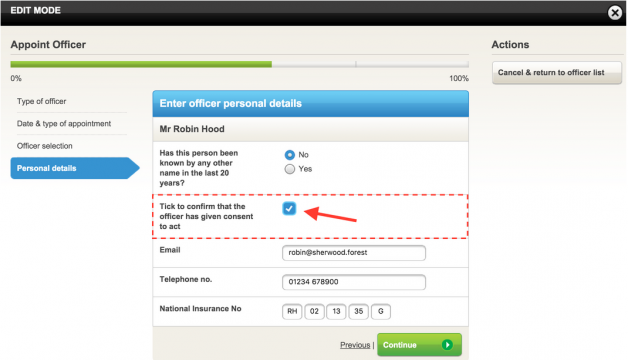Following the Small Business, Enterprise and Employment Act 2015 receiving royal assent, a new procedure for confirming “consent to act” when appointing directors and secretaries comes into force on 10th October 2015. In this article we look at the new consent to act rules and provide a free template that companies and their officers can use to help meet the new requirements.
There are two elements to the new consent to act process:
1 Document that the officer has consented to act
The underlying company should document that the new director has consented to act. This is probably best done by asking them to sign a ‘Consent to Act’ form so there is a written record in place. We’ve created a free template consent to act form which you can download and use. There’s a separate template for appointing a corporate officer. The consent to act form should be retained by the company. It would need to be produced if the individual subsequently claimed that they had been falsely appointed.
A further benefit of the Consent to Act template is that it also prompts the individual (or corporate body in the case of corporate officers) to provide all the other information required to successfully file an appointment with Companies House.
2 New procedure to advise Companies House of an officer's consent
The second element is the new procedure the company must follow to advise Companies House that the director or secretary has given their consent. From 10th October 2015 all new appointments and incorporation requests (Form IN01) – whether paper or electronic – require the company to make a statement that the new officer has consented to act in their relevant capacity. Any appointments made that do not include this statement will be rejected.
All appointments and incorporations made using Inform Direct contain a simple facility for the company to do this. Inform Direct will not allow either submission to be completed until a ‘Consent to Act’ confirmation has been ticked. This ensures that you do not accidentally omit to advise Companies House that consent has been obtained – an omission that would result in rejection of the submission.
Note: the new Consent to Act procedure will apply to all appointments newly notified to Companies House, even if they happened before 10th October 2015.
Once a new appointment has been accepted, Companies House will write to the new officer – even if they have been an officer many times already. The purpose of this correspondence is to ensure that the new officer is aware that their appointment has been filed on the public register and to explain the statutory duties that go with the appointment (as set out by the Companies Act 2006 and other legislation).
Why the change?
The reason that Companies House has introduced this new consent to act measure is to have a simple process that will help resolve any disputes arising should a director or secretary claim that they had not consented to act in their appointment. Where an individual claims that they were falsely appointed, the company will be required to produce a hard copy of the Consent to Act form, duly signed by the officer concerned.
Manage a UK company?
An important part of managing a UK company is keeping its statutory books and filings up to date.
Inform Direct is the perfect free tool to help make this task a whole lot easier.
Good practice
The company should minute the appointment of any new officers. It would be good practice to produce the completed Consent to Act form at the board meeting and record that it has been properly completed.



Do existing companies need to file with coho?
For any appointments that you have already made, and that have already been accepted by Companies House, no further action is required. However, if you are processing an appointment on or after the 10th October 2015, even if the appointment happened before this date, the new consent to act statement must be completed. This applies both to existing companies and to new formations, from 10th October 2015 onwards. I do hope this answers your query.